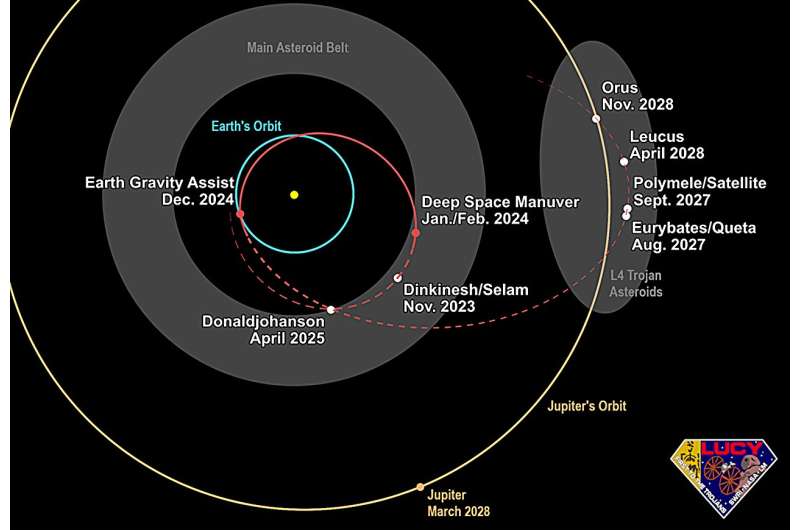This article has been reviewed according to Science X's editorial process and policies. Editors have highlighted the following attributes while ensuring the content's credibility:
fact-checked
trusted source
proofread
NASA's Lucy ready for 2024 mission milestones

After its successful first asteroid encounter in 2023, NASA's Lucy mission has its sights firmly set on its main targets, the never-before-explored Jupiter Trojan asteroids. In 2024, the Lucy spacecraft will transition from its current orbit around the sun—one that just skims the inner-edge of the main asteroid belt—to a new orbit that will carry it beyond the orbit of Jupiter and into the realm of the Trojan asteroids. This will be done in two steps: A series of deep space maneuvers and an Earth gravity assist.
In late January, Lucy will begin the series of two deep space maneuvers. On January 31, the spacecraft will briefly operate its main engines for the first time in space. After analyzing the spacecraft's performance during that brief burn, the team will command the spacecraft to carry out a larger maneuver, nominally on February 3.
Combined, these two maneuvers are designed to change the velocity of the spacecraft by around 2,000 mph (approximately 900 meters per second) and will consume roughly half of the spacecraft's onboard fuel. Each of the prior spacecraft maneuvers have changed the spacecraft's velocity by less than 10 mph (only a few meters per second) and were small enough to be carried out by the spacecraft's less powerful thrusters.
These maneuvers will place Lucy on course for its second milestone of the year, the spacecraft's second Earth gravity assist. In December 2024, Lucy will fly within 230 miles (370 kilometers) of the Earth. This encounter will slingshot the spacecraft through the main asteroid belt, where it will encounter asteroid Donaldjohanson in April 2025, and out into the leading (also called the L4 or "Greek") Jupiter Trojan asteroid swarm. There, Lucy will get its first close-up look at a Trojan asteroid in August 2027, when it reaches Eurybates and its satellite Queta.
Provided by NASA





















